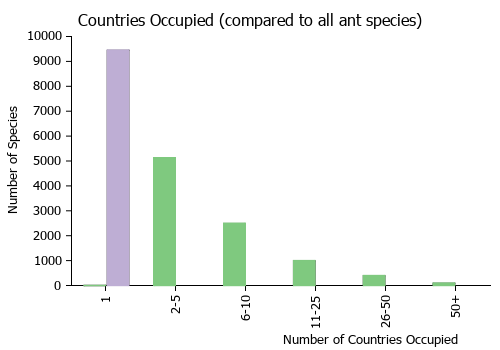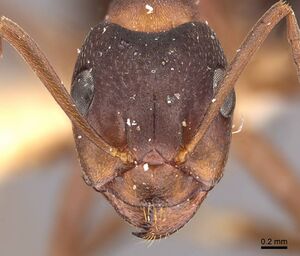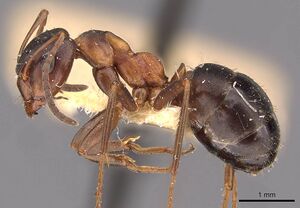Formica pisarskii
| Formica pisarskii | |
|---|---|

| |
| Scientific classification | |
| Kingdom: | Animalia |
| Phylum: | Arthropoda |
| Class: | Insecta |
| Order: | Hymenoptera |
| Family: | Formicidae |
| Subfamily: | Formicinae |
| Tribe: | Formicini |
| Genus: | Formica |
| Subgenus: | Coptoformica |
| Species: | F. pisarskii |
| Binomial name | |
| Formica pisarskii Dlussky, 1964 | |
| Synonyms | |
| |
The main habitat of F. pisarskii is open and rather dry steppe, but it may also occur in fresh meadows and light woodland. Nests are typically mounds of finely cut grass particles but in the stony mountain steppe of Mongolia they are predominately under stones – as a rule without adherent piles of grass particles. A most probable host species for socially parasitic colony foundation is Formica candida which was observed in any site where F. pisarskii was found. Alates were seen in the nests 1 August 2001 in NE Tibet and 8 August 2003 in Mongolia. (Seifert & Schultz, 2021)
| At a Glance | • Temporary parasite |
Identification
Seifert (2000) - F. pisarskii is a species with a unique character combination. There is no other species in the genus with workers combining strongly developed clypeal and pronotal setae with reduced eye hairs and extremely large frontal and gastral pubescence distance. The queens can only be confused with those of Formica suecica and Formica forsslundi but pisarskii differs from the first by the extremely large PDF and PDG and the elongated head and from the latter by the presence of posterior clypeal setae and the large SL/CW (0.934, in forsslundi 0.770-0.888).
Distribution
Seifert (2000) - The known distribution is limited to Mongolia. Dlussky (1965) mentioned two records from in Central Siberia (Chitinskaya oblast’) and East Siberia (Yakutsk) of which I did not see voucher specimens.
The Reinig Line faunal divide separates East Siberian, Inner Mongolian, Chinese and Tibetan species from those of Central Siberia, West Siberia and the Turanian region (DE LATTIN, 1967). In ants, the Reinig Line is crossed only by a cold resistant species including Camponotus herculeanus, Formica exsecta, Formica gagatoides, Formica lugubris, Formica manchu, Formica picea, Formica pisarskii, Formica uralensis, Lasius flavus, Leptothorax acervorum and Tetramorium sibiricum (DLUSSKY, 1967; FRANCOEUR, 1983; SEIFERT, 2000, 2021a, 2021b).
Latitudinal Distribution Pattern
Latitudinal Range: 62.033889° to 44.727613°.
| North Temperate |
North Subtropical |
Tropical | South Subtropical |
South Temperate |
- Source: AntMaps
Distribution based on Regional Taxon Lists
Palaearctic Region: Mongolia (type locality).
Distribution based on AntMaps
Distribution based on AntWeb specimens
Check data from AntWeb
Countries Occupied
| Number of countries occupied by this species based on AntWiki Regional Taxon Lists. In general, fewer countries occupied indicates a narrower range, while more countries indicates a more widespread species. |

|
Estimated Abundance
| Relative abundance based on number of AntMaps records per species (this species within the purple bar). Fewer records (to the left) indicates a less abundant/encountered species while more records (to the right) indicates more abundant/encountered species. |

|
Habitat
Southern slopes of hill tops with sparse grassy vegetation.
Biology
Flight Period
| X | |||||||||||
| Jan | Feb | Mar | Apr | May | Jun | Jul | Aug | Sep | Oct | Nov | Dec |
Source: Seifert & Schultz, 2021.
- Check details at Worldwide Ant Nuptial Flights Data, AntNupTracker and AntKeeping.
 Explore: Show all Flight Month data or Search these data. See also a list of all data tables or learn how data is managed.
Explore: Show all Flight Month data or Search these data. See also a list of all data tables or learn how data is managed.
Association with Other Organisms
 Explore: Show all Associate data or Search these data. See also a list of all data tables or learn how data is managed.
Explore: Show all Associate data or Search these data. See also a list of all data tables or learn how data is managed.
- This species is a xenobiont for the ant Formicoxenus nitidulus (a xenobiont) (Holldobler & Wilson 1990; Busch 2001; Martin et al. 2007).
- This species is a xenobiont for the ant Formicoxenus sibiricus (a xenobiont) (Seifert, 2023) (misidentified as Formica pressilabris).
Castes
Images from AntWeb
   
| |
| Paratype of Formica pisarskii. Worker. Specimen code casent0907593. Photographer Z. Lieberman, uploaded by California Academy of Sciences. | Owned by MZL, Lausanne, Switzerland. |
Nomenclature
The following information is derived from Barry Bolton's Online Catalogue of the Ants of the World.
- pisarskii. Formica (Coptoformica) pisarskii Dlussky, 1964: 1034, figs. (w.q.) MONGOLIA. See also: Kupyanskaya, 1990: 204; Seifert, 2000a: 551.
Unless otherwise noted the text for the remainder of this section is reported from the publication that includes the original description.
Description
Worker
Seifert (2000) - Medium-sized (CL 1322 ± 54, 1200-1384). Head elongated (CL/CW 1.069 ± 0.020, 1.039-1.109). Rather long scape (SL/CL 1.009 ± 0.020, 0.971-1.043). Whole clypeus from anterior to caudal parts with scattered setae (ClySet 4.47 ± 0.52, 4-5). Clypeus lateral of the tentorial pit level without or very few pubescence hairs surpassing the anterior margin by > 10 μm. Lateral semierect setae in the ocellar triangle usually present (OceSet 93%). Eye hairs short or absent (EyeHL 7.2 ± 5.5, 0-19). Pubescence in the occellar triangle very dilute (sqrtPDF 7.11 ± 0.45, 6.47-7.84). Craniad profile of forecoxae with few semierect setae (nCOXA 3.74 ± 1.08, 2-6). Dorsal pronotum always with few standing setae (nPN 7.23 ± 3.30, 4-16). Dorsal crest of petiole with few setae. Lateral metapleuron and ventrolateral propodeum only occasionally with single setae (nMET 0.03 ± 0.12, 0-0.5). Outer edge of the hind tibial flexor side conspicuously hairy (nHTFL 8.06 ± 0.93, 7.0-10.5). Semierect setae on gaster tergites always beginning on the first tergite (TERG 1.0 ± 0.0) and distributed over its whole surface. Pubescence distance on first gaster tergite very large (sqrtPDG 7.76 ±0.43, 7.04-8.84).
Queen
Seifert (2000) - (One paratype queen). Very small (CL 1270, CW 1221, ML 2099). Head long (CL/CW 1.040), scape rather long (SL/CL 0.898). Clypeus from anterior to posterior portions with scattered standing setae (ClySet 4). Clypeus lateral of the tentorial pit level without pubescence hairs surpassing the anterior margin by > 10 μm. Lateral semierect setae in the ocellar triangle present. Eye hairs very short and sparse (EyeHL 7). Pubescence in the occellar triangle extremely dilute (sqrtPDF 7.84). Occipital corners of head with appressed pubescence (OccHD 0.0). Dorsal head brilliantly shining (GLANZ 3.0); whole body very dark and shining, almost without microsculpture. Craniad profile of forecoxae with few setae (nCOXA 2.0). Promesonotum with many standing setae (nPN 14, MnHL 99). Outer edge of the hind tibial flexor side conspicuously hairy (nHTFL 9.0). Semi-erect setae on gaster tergites beginning on the first tergite (TERG 1.00) and not restricted to its caudal margin. Pubescence distance on first gaster tergite extremely large (sqrtPDG 8.11).
Type Material
Songino (24 km SW of Ulan Bator), Mongolia. Syntypes 1 queen, 10 workers (Zoological Museum of the Moscow State University) (Museum of the Zoological Institute of the Polish Academy of Sciences) (MZ No. 3297-3299) [investigated].
References
- Antonov, I.A., Bukin, Yu.S. 2016. Molecular phylogenetic analysis of the ant genus Formica L. (Hymenoptera: Formicidae) from Palearctic region. Russian Journal of Genetics 52(8), 810–820 (doi:10.1134/s1022795416080020).
- Dlussky, G. M. 1964. The ants of the subgenus Coptoformica of the genus Formica (Hymenoptera, Formicidae) of the USSR. Zool. Zh. 4 43: 1026-1040 (page 1034, figs. worker, queen described)
- Goropashnaya, A.V., Fedorov, V.B., Seifert, B., Pamilo, P. 2012. Phylogenetic relationships of Palaearctic Formica species (Hymenoptera, Formicidae) based on mitochondrial Cytochrome b sequences. PLoS ONE 7, e41697 (doi:10.1371/journal.pone.0041697).
- Kupyanskaya, A. N. 1990a. Ants of the Far Eastern USSR. Vladivostok: Akademiya Nauk SSSR, 258 pp. (page 204, see also)
- Seifert, B 2000a. A taxonomic revision of the ant subgenus Coptoformica Mueller, 1923 (Hymenoptera: Formicidae). Zoosystema 22:517-568. (page 551, see also)
- Seifert, B. 2021. Surviving the winter: Tetramorium sibiricum n. sp., a new Central Siberian ant species (Hymenoptera: Formicidae). Osmia 9, 15–24 (doi:10.47446/osmia9.3).
- Seifert, B., Schultz, R. 2021. A taxonomic revision of the Palaearctic ant subgenus Coptoformica Müller, 1923 (Hymenoptera, Formicidae). Beiträge zur Entomologie 71 (2): 177–220 (doi:10.21248/contrib.entomol.71.2.177-220).
References based on Global Ant Biodiversity Informatics
- Chesnokova S. V., and L. V. Omelchenko. 2011. Ants of Central Altai: Spatial-Typological Structure and Classification of Communities. Entomological Review 91(2): 253263.
- Kupianskaia A.N. 1990. Murav'I (Hymenoptera, Formicidae) Dal'nego Vostoka SSSR (1989). Vladivostok. 258 pages.
- Pfeiffer M., R. Schultz, A. Radchenko, S. Yamane, M. Woyciechowski, U. Aibek, and B. Seifert. 2007. A critical checklist of the ants of Mongolia (Hymenoptera: Formicidae). Bonner Zoologische Beiträge 55: 1-8.
- Pisarski B. 1969. Fourmis (Hymenoptera: Formicidae) de la Mongolie. Fragmenta Faunistica (Warsaw). 15: 221-236.
- Shilenkov V. G., A. A. Pankratov, and E. V. Sofronova. 2012. Preliminirary notes on species composition of Magdansky Reserve. Baikal Zoological Journal 3: 30-34.
- Siberian Zoological Museum. Website available at http://szmn.sbras.ru/old/Hymenop/Formicid.htm. Accessed on January 27th 2014.
- Zhigulskaya Z. A. 2009. The ants of the Chuya Depression and the Yustyd river basin in Southeastern Altai. Contemporary Problems of Ecology 2009 2(3): 210-215.
- Pages using DynamicPageList3 parser function
- Ant Associate
- Host of Formica candida
- Temporary parasite
- Need species key
- North temperate
- FlightMonth
- Host of Formicoxenus nitidulus
- Host of Formicoxenus sibiricus
- Species
- Extant species
- Formicidae
- Formicinae
- Formicini
- Formica
- Coptoformica
- Formica pisarskii
- Formicinae species
- Formicini species
- Coptoformica species
- Formica species
- Ssr

